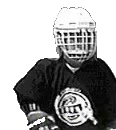I like to respond quickly to member requests (hey, being here for YOU is what I and CoachChic.com should be all about).
I mention this because Tim T just wrote and asked, "What are some situations where a coach would have players back off from an aggressive forecheck?"
Ah, what an awesome question, and it's one that I actually wanted to address with my members sometime this month...
-- Dennis Chighisola
A Flexible Hockey Forecheck
 Actually, that title is not the way I usually present this line of thinking to my players. I happen to call it "Facing-up", while I know some other coaches refer to it as the "Logo Forechecking". Both make sense, as you'll soon discover.
Now, in case you don't totally appreciate Tim's question, I think the best way to begin is to share something I witnessed a few years ago while watching one of my grandson's high school hockey games...
Actually, that title is not the way I usually present this line of thinking to my players. I happen to call it "Facing-up", while I know some other coaches refer to it as the "Logo Forechecking". Both make sense, as you'll soon discover.
Now, in case you don't totally appreciate Tim's question, I think the best way to begin is to share something I witnessed a few years ago while watching one of my grandson's high school hockey games...
He played in a pretty high caliber league back then, which not only included a lot of great players, but also a lot of pretty sharp coaches.
Anyway, one evening The Good Guys played a very talented and well coached team from Rhode Island.
Every so often I'd hear some fairly loud communications going on down on the ice below me, this usually happening as the RI team dumped the puck and moved into their forecheck.
It only took a few instances for me to understand what the yelling was all about. You See, if my grandson's team was able to quickly gather the dumped puck, there was the likelihood that they could begin their breakout before the RI group could move into their aggressive forechecking positions.
Now, think about that a little more if you need to... In other words, as Tim T has suggested, an aggressive forecheck is going to get stuck -- or trapped -- any time the opponents are able to start their breakout quicker than the aggressive forecheck can be deployed.
As I recall, the RI team was using a version of the 2-1-2 as their basic aggressive forecheck. However, what I'd hear one or more of their forwards yelling at times was, "One! One!" Yup, upon seeing certain conditions unfolding in front of them, at least one lead forward would alert everyone else as to the need to abandon their aggressive 2-1-2, and to instead move into a more conservative scheme that had only one forward pressuring the puck.
Okay, so you're wondering where the "logo" or "facing-up" designations come in?
Well, as I've heard other coaches say, one good way to determine whether it is safe to be aggressive or not is spot whether the earliest forechecker/s can see the logo on the front of the rival puckcarrier's jersey. Said yet another way, if an enemy puckcarrier has good control of the puck -- and he's already facing-up ice -- as you're moving into the offensive zone, it might not be wise to be aggressive.
 Again, I think the use of the term "logo" is fine. However, as I attempted to teach related principles to my high school prep team a few years back, I wanted whatever key word or phrase I'd use to cover a number of things...
Again, I think the use of the term "logo" is fine. However, as I attempted to teach related principles to my high school prep team a few years back, I wanted whatever key word or phrase I'd use to cover a number of things...
As I mentioned just moments ago, an opponent's good control of the puck is as important in this read as is his posture (like facing-up the ice). I mean, if you can see that player's logo but he's fumbling with a puck in his skates (or whatever), there might still be a chance to check aggressively.
Then, while I've never heard this kind of reading and reacting mentioned by hockey color commentators during television broadcasts, I can assure you that every high level team employs some form of this decision-making. They use it as I've described above, and they'll at least use it while in the midst of a line change.
Of course, the first question I expect from member coaches will have to do with the age groups that might be able to deploy this kind of tactic. So, in my opinion, it should at least be used by teams from Midgets and high schools on up through juniors, colleges and pros.
Could pretty headsy Pee Wees and Bantams use it? I think so. The main criteria, as far as I'm concerned, would be that a team be able to understand and effectively apply two drastically different types of forechecks -- one being aggressive, the other being conservative.
Oh, and one last thing... Within this "Thinking the Game" category, you're going to hear me frequently refer to the need for players to play with balance, and to be able to think and skate at the same time. Ya, as a player moves up the hockey ladder, he or she can't just run around without a purpose. And ultimately, he or she is going to need to read and react to various situations much like I've described here.

No comments:
Post a Comment